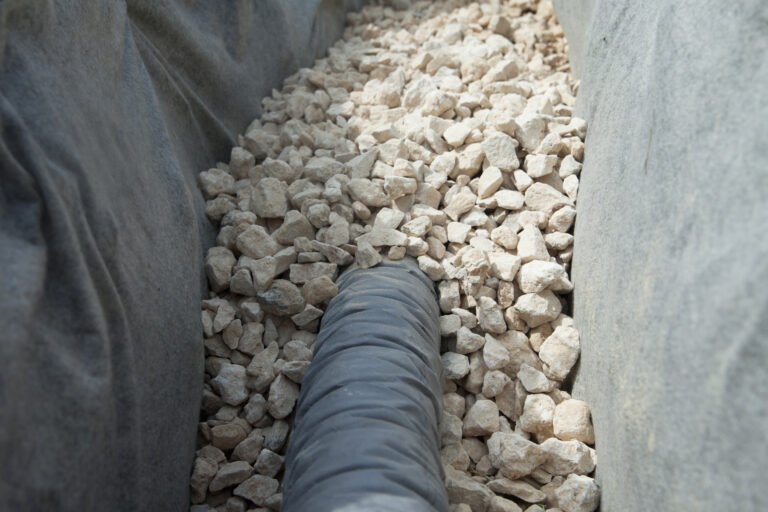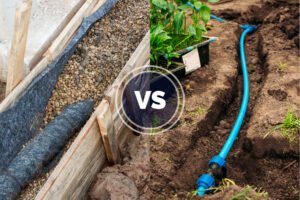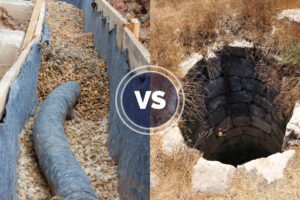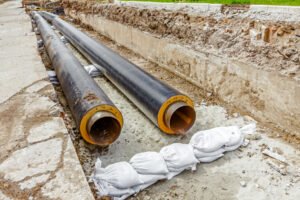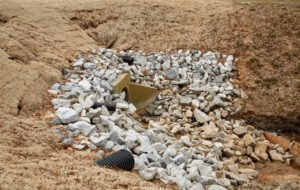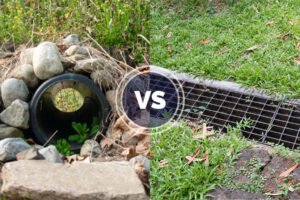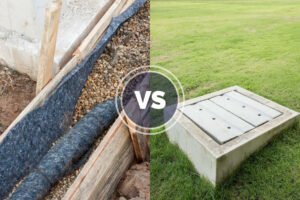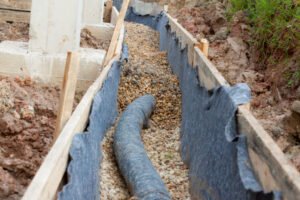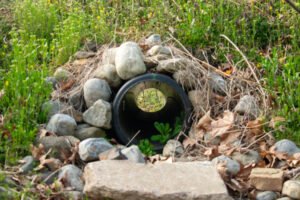Isn’t it daunting to filter the soil and roots from your french drain? Someone might have suggested you to wrap a sock around the french drain pipe for better erosion control, but the wool will only damage the pipe further. And, of course, the fabric might not last long and aggravate the drainage problem.
This is why choosing the right drainage fabric is a must. But, which is the best fabric for french drain? Join us as we scrutinize different types of fabrics to pick the best one for your yard. Let’s check it out!
Woven linen is the best fabric to support the trench, while non-woven geotextiles are the best to prevent water percolation and soil erosion in medium-sized french drains. But, avoid using synthetic nylon fabrics as they may tear and clog your drain system.
Which Are Some of the Best French Drain Fabrics?
You can line the trench with any woven linen or non-woven fibrous landscaping fabric during the french drain installation. But don’t forget to check the fabric thickness, cost, and applications below and pick the one that best suits your drainage system’s depth.
1. Woven Geotextile
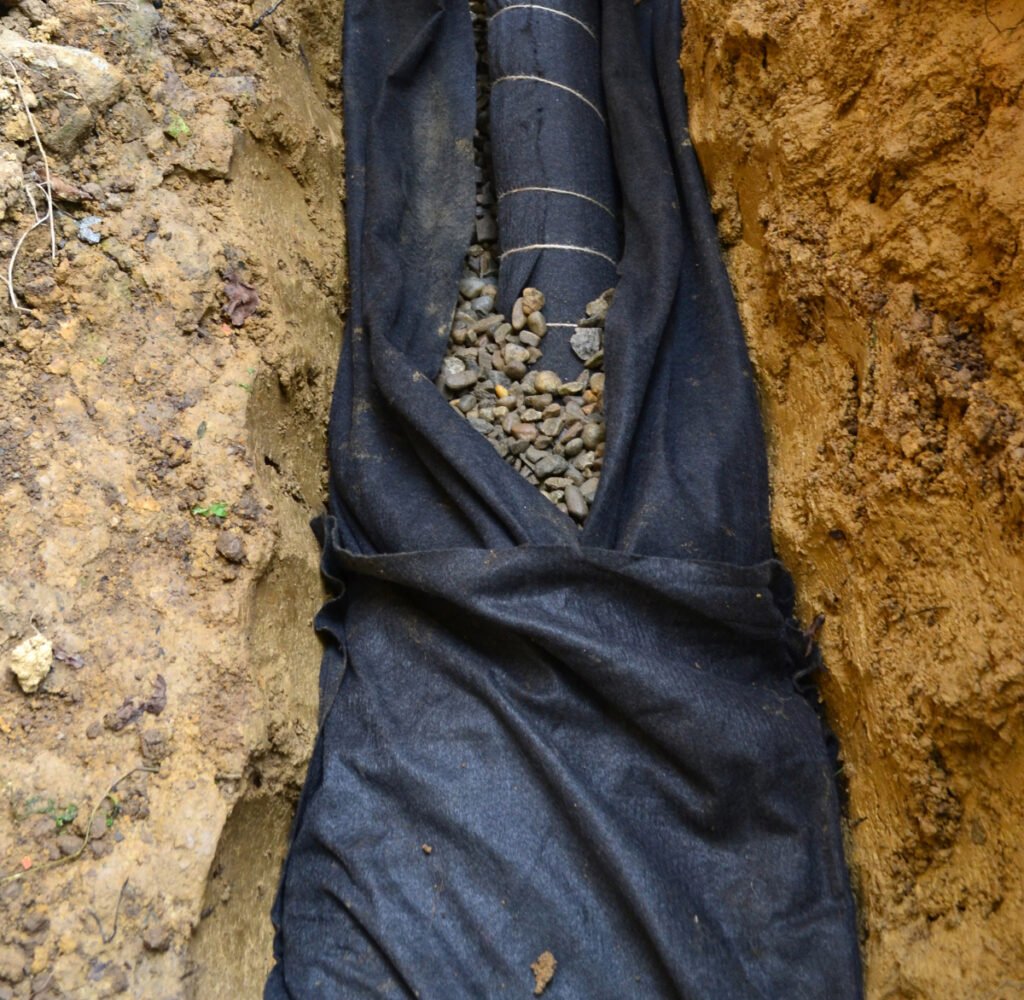
What Is It: A woven landscape fabric is a simple cotton, linen, polypropylene, or polyester yarn with impermeable paper-plastic sheets glued to both sides.
Woven fabrics are hand-spun cotton geotextiles with greater compressive strength, reinforcement, and warp resistance. So, they are used to support the deeper trenches and gravel under high-load parking lots, driveways, decks, and patios. They are not only mold and mildew resistant but prevent soil and root infiltration efficiently.
However, these have slow drainage and might cause flooding with heavy rain. Plus, they might retain standing water in the perforated pipe and may need a sump pump for faster water flow. But these are highly stiff, non-porous, and pack heavier river gravel, crushed stone, and pipe within the trench.
Woven Geotextile is further divided into three subtypes:
- Silt Film Woven Fabric: Silt film is a meshed plastic landscape fabric with stiffer metal and wooden stakes that prevents sediment from running down the trench slope and clogging the perforated drain pipe.
- Monofilament Drainage Fabric: It is a stiffer and flexible polyester or poly fiber yarn that reinforces a deeper trench, absorbs the excess water, and relieves the hydrostatic pressure from the retaining wall and crawl space.
- Combination Geotextile: It is a mixed cotton and polymer landscape fabric with wider weaves for faster landscape drainage and a greater sediment resistance in clay soil.
Best Used For: A deeper or exterior french drain along paved areas, basements, and parking lots.
| Standard Size | 15 X 5 or 3 X 100 feet |
| Average Weight | 4 – 6 pounds per foot |
| Rough Cost | $1 – 3 per foot |
Pros:
- Lightweight, Easy to lay and curve
- Higher tensile strength, crushing strength, and stability
- Doesn’t expand and contract with temperature fluctuations
- Anti-acid, anti-alkali and high pest resistance
- Protects the pipe from weather and corrosion
- Reinforces weaker soil and clay
- Holds up to 18 – 20 inch trench gravel
Cons:
- Low permeability and drainage speed
- Might tear with sharper french drain rock and gravel
- Retains water in the drain system
- Might not fit around the grooves and connections of a corrugated pipe
Use monofilament or combination woven fabric to prevent flooding and drain the surface water in heavy rainfall areas.
2. Non-woven Drainage Fabric
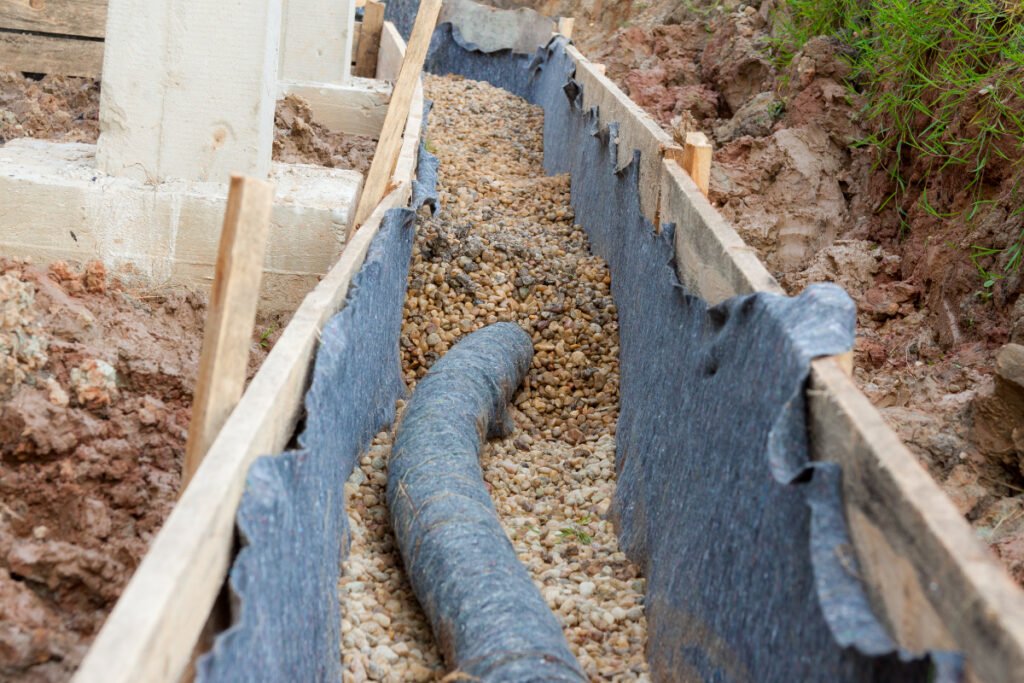
What Is It: A non-woven landscape fabric is a polyester filament or fiber fabric with wider honeycomb weaves and short plastic filaments that filter the soil and sediment.
Non-woven filter fabric is a poly-spun fabric for fast drainage in shallower, overflowing drains in high rainfall areas. It is primarily used for filtration and groundwater stabilization along the basement drains, but it also offers greater stability under lawn and garden drains. It also has good adhesion and does not tear easily.
However, non-woven fabrics are vulnerable to root and pest infiltration and need periodic maintenance for proper functioning. But, these are easy to lay and bend along the trench slopes easily.
Additionally, they help drain the excess water to the surrounding soil and prevent standing water in the french drain system.
Further, we have three types of this drain field fabric based on weight and use:
- 3 Pound Fabric: It is a lightweight, flexible drainage fabric that filters soil and allows faster drainage along retaining walls and foundations.
- 4-6 Pound Fabric: This filter fabric prevents soil erosion and displacement in deeper french or trench drains and efficiently holds lighter gravel under pathways and patios.
- 8-16 Pound Fabric: The drainage fabric provides additional cushioning to lawn and garden drains and prevents roots from seeping into the PVC pipe and clogging it.
Best Used For: Shallower garden drains or backyard drains in high rainfall or flooding areas
| Standard Size | 6.5 X 300 or 10 X 100 feet |
| Average Weight | 2 – 16 pounds per foot |
| Rough Cost | $3 – 6 per foot |
Pros:
- High adhesion and workability in shallower french drains
- Excellent friction resistance and durability
- Prevents root and sediment clogs
- Filters water and reduces hydrostatic pressure
- High drainage speed
- Reduces flooding and marshiness
Cons:
- Little expensive and difficult to install
- Might not work in deeper drains
- Doesn’t support heavier gravel or drainage pipe
Use 3 – 4.5 pound filter fabric for better drainage in standard, backyard french drains, but pick sturdier 12 – 14 pound drainage fabrics for larger, clayey french drains.
Comparing the Best Fabrics for French Drainage System
| Parameter | Woven Landscape Fabric | Non-woven landscape fabric |
| Drainage Speed | Low | High |
| Type of Soil | Clayey or Weaker Soil | Coarse-grained soil |
| Application | Trench reinforcement and Pipe support | Filtration and Ground stabilization |
| Flow Rate | 90 – 100 GPM* | 140 GPM* |
| Weather Resistance | High | Moderate |
| Pipes to Use | Solid PVC or Perforated PVC Pipe | Corrugated or Perforated Pipe |
| Cost | Low | Moderate |
| Durability | Moderate | High |
| Location | Exterior or Driveway drains | Basement or Garden drains |
Note: GPM – Gallons per Minute.
Which Fabric Should Not Be Used in a French Drain Trench?
French drains are under continuous water exposure and need a sturdier, meshed fabric for proper strength and filtration. However, some fabrics might not meet the requirements and cause a drainage issue with excess surface drain runoff.
But, what types of fabric should you avoid for a french drain? Let’s find out below.
- Rayon and Nylon: Man-made fabrics like Rayon and Nylon might pollute the stormwater runoff and contaminate the drainage ditch or low-lying site areas. Plus, they might tear and clog the perforated pipe.
- Wool: Woolen socks or scarves filter the drain water but have lots of threads and strands that might hamper the smooth functioning of the drain pipe.
- Bamboo Mats: Weaved bamboo mats might look natural but are gradually vulnerable to pest and fungus attacks. Plus, they get soiled easily and won’t keep the sediment away.
Which Is the Best Landscape Fabric for Clay Soil?
A monofilament or combination woven fabric is the best to eliminate flooding in clayey or soggy soil. However, you can also pick sturdier 16oz non-woven fabric and line the french or trench drain with 2-inch river gravel for efficient drainage.
Which Is the Best Landscape Fabric to Support Grass?
8-16 pound non-woven fabrics are the best to support grass over a french drain. They are stiff, keep grassroots away from the drain pipe, and do not hamper the water flow. But, you can use a 6-pound fabric and line the trench with river rock to support turf and lawns.
A landscape fabric cannot stop the root infiltration and sedimentation in the pipe alone and needs the right french drain rock for efficient function. So, add at least 8-10 inches of gravel before planting grass.
Which Fabric Is Best for French Drains Under Driveways?
Woven plastic-lined fabric withstands the driveway’s constant movement and vibrations but prevents flooding and water percolation in paved areas. Similarly, a 4-6 pound fabric helps fast drainage and can be used for all the pathways that connect to the main driveway.
Which Fabric Is the Best for French Drains Connected to a Catch Basin?
Non-woven 8-12oz fabrics are the best to channel the catchbasin’s heavy runoff and discharge it to the surrounding soil. But, you can also use a thinner 3oz fabric and a sump pump to drain water from shallower french drains and catch basins.
Standards of French Drain Fabric Installation
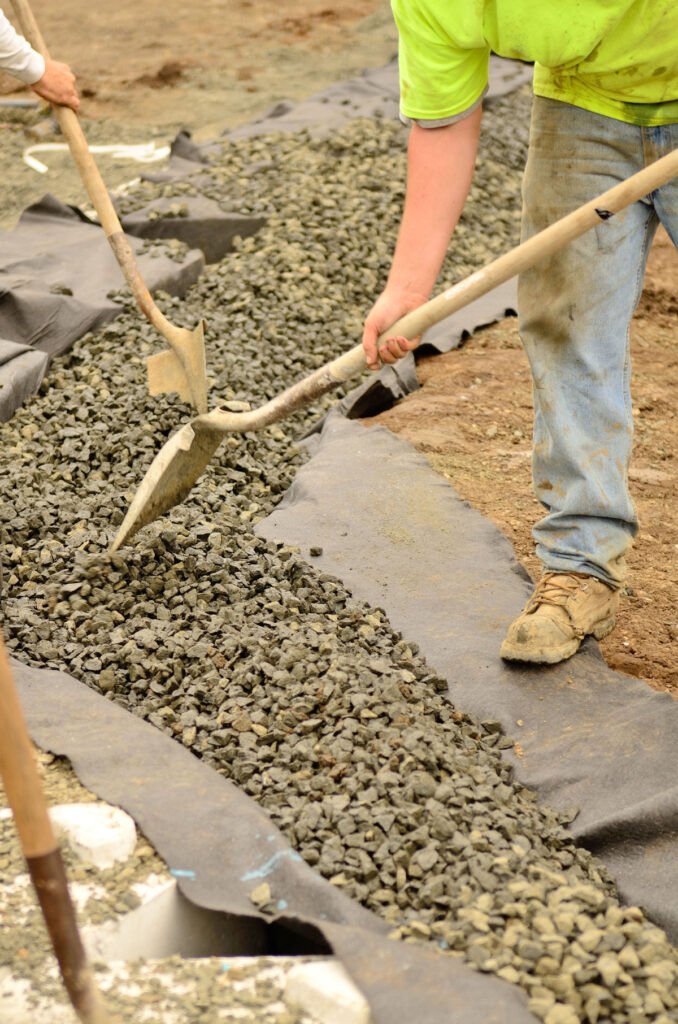
The homeowners association has a fixed set of rules that determine the depth and weather resistance of landscaping fabrics. However, many people commit french drain mistakes here and end in penalties. So, check out some of the rules before you proceed.
- French drain fabrics must be porous enough to handle the surface water runoff but should not interfere with the natural filtration of the surrounding soil.
- The top layer drain fabric must be about 200-300mm below the ground surface.
- The filter fabric must retain all the dirt and sediments without clogging the drain pipe.
- The drainage fabric should not tear because of the tree’s roots and sharper trench gravel.
- You must call a professional french drain man and install a french drain root barrier in heavily planted areas or gardens.
- Use a sump pump for a smart drainage solution and quick water discharge in heavy rainfall areas.
Tips to Pick the Best Fabric for a French Drain System:
- Pick lighter 2-3oz drainage fabric for a faster installation in shallower french drains.
- Use woven geotextiles under driveways and pathways, but choose a non-woven drainage fabric in any softscape area.
- Select woven fabrics for deeper basement drains and limit non-woven fabrics to shallower drains.
- Choose a woven landscape fabric in areas of clay soils or weaker aggregate.
- Pick a combination woven fabric to protect your pipe from sharp, angular gravel in hilly areas.
- You can also purchase a fabric-encased perforated pipe for easy installation and maintenance.
What Should Be the Ideal Width of a French Drain Fabric?
French drain fabrics must be wider than the trench’s width to prevent gravel and dirt from falling onto the pipe and disrupting the water flow. So, you can use 3-feet fabric for shallower drains and 6-feet fabric for deeper drains.
What Is the Best Fabric Weight for a French Drain?
A 3 – 5 pound fabric is the best for a french drain and will not only support shallower trenches but also prevent root and sediment infiltration.
Does Landscape Fabric Allow Drainage?
Yes, landscape fabric allows water to drain into the surrounding soil but holds all the significant dirt and debris that might clog the french drain pipe.
What Is a Drain Field Fabric?
A drain field fabric is nothing but a thinner landscape fabric sandwiched between two layers of gravel for better protection from grass and tree roots.
Are There Any Alternatives to Landscape Fabric?
Yes, you can use cardboard, burlap, or weed filters instead of landscape fabric. But, use these alternatives in low-rainfall areas or shallower french drain alternatives to prevent backflow.
How Much Sand Can You Put on Top of a Landscape Fabric?
You can put about 10 inches of sand on top of your landscape fabric to support the grass and plants, but don’t forget to use a weed liner to protect your pipe from decay.
What Is the Difference Between a Landscape Fabric and Geotextile Fabric?
Woven geotextile fabric is used to stabilize the ground and support deeper trenches from falling off. In contrast, a non-woven landscape fabric is used to prevent overflow in shallower drains and trenches.
Drain fabrics hike your french drain cost but are essential to reduce maintenance and clogging in the long run. So, you can use different types of woven and non-woven drainage fabrics along your driveways and gardens. These will protect the drain pipe and enhance its durability.
Moreover, these fabrics come in different weights and thicknesses. So, you can pick one based on your drainage issue, drain location, and runoff percentage. Also, don’t forget to use the right drain pipe to channel the excess water and prevent overflowing. You can check ‘the best drain pipe for your french drain’ right here!

